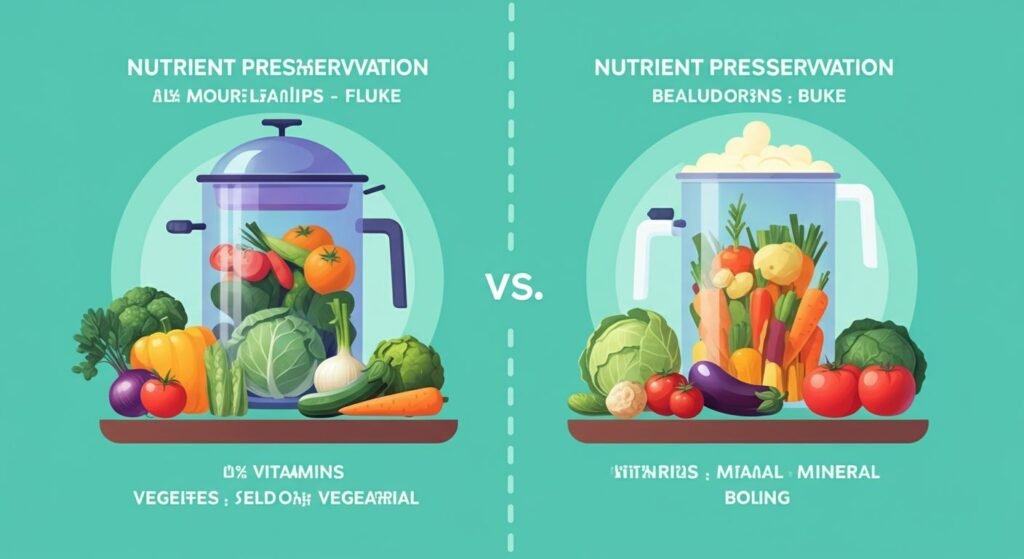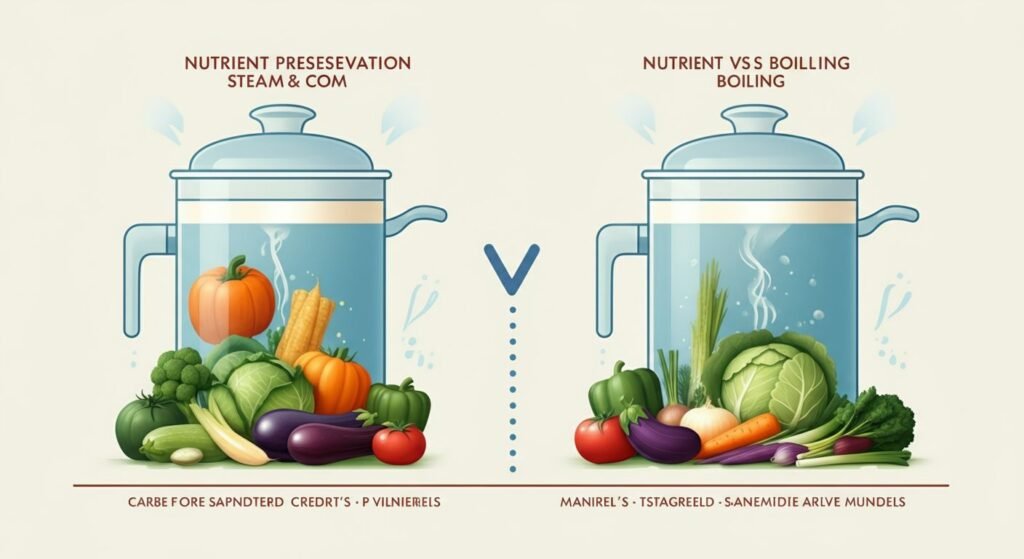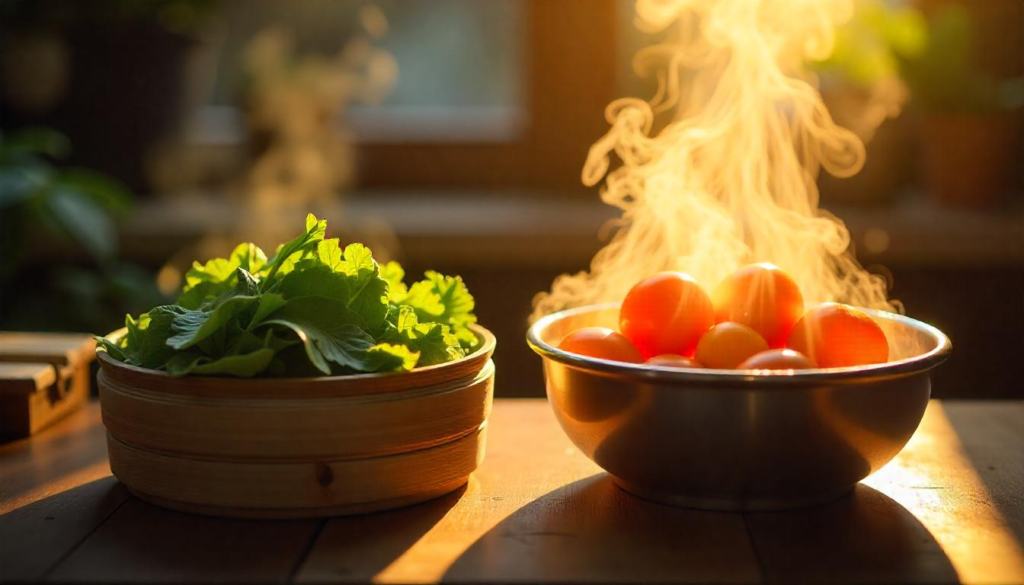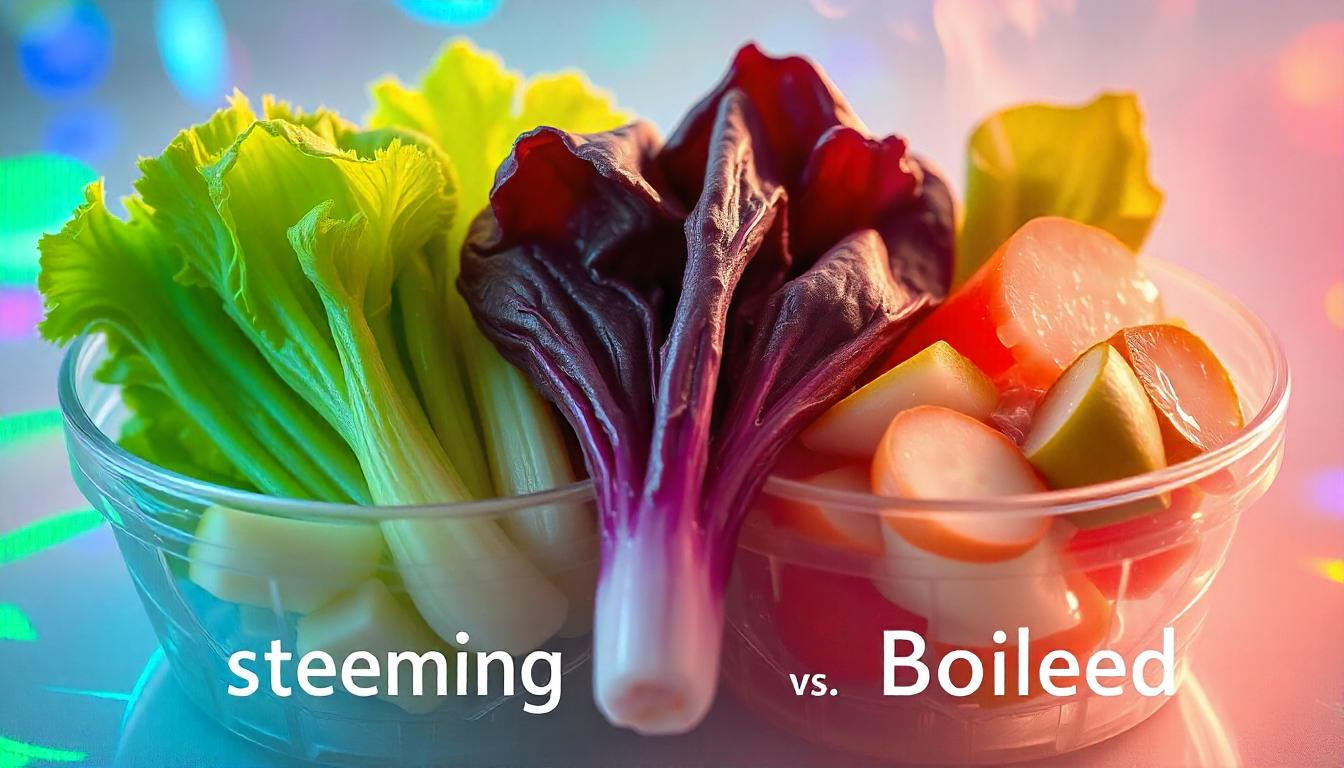“7 fascinating facts about steaming and boiling. Learn which method preserves nutrients better and how it impacts your health.”

Introduction
Overview of Steaming and Boiling as Cooking Methods
Steaming and boiling are two popular cooking methods used to prepare a variety of foods. Both methods involve the use of water, but they differ in how the water interacts with the food.
- Steaming: In steaming, food is placed in a steamer basket or on a rack above boiling water. The steam generated from the boiling water cooks the food. This method is gentle and helps retain the food’s natural flavors, colors, and nutrients.
- Boiling: In boiling, food is fully submerged in boiling water. The high temperature of the water cooks the food quickly. Boiling is a straightforward method and is often used for cooking vegetables, pasta, and grains.
Importance of Understanding Nutrient Preservation
Understanding nutrition preservation is crucial for making informed decisions about cooking methods. Different cooking methods can affect the nutritional content of foods in various ways. Some methods may cause significant nutrient loss, while others help retain more nutrients. By choosing the right cooking method, you can maximize the nutritional value of your meals and support your overall health.
Purpose of the Article
The purpose of this article is to explore the differences between steaming and boiling with a focus on nutrient preservation. We will delve into the scientific findings on nutrient retention, examine the impact of these cooking methods on flavor and texture, and provide practical tips and recipes for optimal cooking. By the end of this article, you will have a better understanding of which cooking method is best for preserving nutrients and enhancing the overall quality of your meals.

Fact 1: Nutrient Preservation
Steaming vs. Boiling: Nutrient Retention
One of the key differences between steaming and boiling is their impact on nutrient retention. Steaming is generally considered a superior method for preserving nutrients compared to boiling.
- How Steaming Preserves More Nutrients Compared to Boiling: When food is steamed, it is not in direct contact with water. This helps prevent the leaching of water-soluble vitamins and minerals into the cooking water. As a result, steamed foods tend to retain more of their nutrients. In contrast, boiling involves submerging food in water, which can cause significant nutrient loss, especially for water-soluble vitamins like vitamin C and B vitamins.
- Vitamins and minerals affected by cooking methods: Water-soluble vitamins, such as vitamin C and B vitamins, are particularly susceptible to nutrient loss during boiling. Minerals like potassium and magnesium can also leach into the cooking water. Steaming helps minimize this nutrient loss, making it a better option for preserving the nutritional value of foods.
Scientific Studies on Nutrient Preservation
Numerous scientific studies have examined the effects of steaming and boiling on nutrients retention. These studies consistently show that steaming is more effective at preserving nutrients compared to boiling.
- Research Findings on Nutrient Retention in Steamed vs. Boiled Foods: Research has shown that steaming can retain up to 90% of certain nutrients, while boiling may only retain around 50-60%. For example, a study found that steaming broccoli preserved more vitamin C and glucosinolates (compounds with cancer-fighting properties) compared to boiling.
- Examples of Nutrient Retention in Different Vegetables Different vegetables respond differently to cooking methods. For instance, steaming spinach helps retain more folate and vitamin C compared to boiling. Similarly, steaming carrots preserves more beta-carotene, an important antioxidant, than boiling.

Fact 2: Flavor and Texture
Impact on Flavor and Texture
The cooking method you choose can significantly impact the flavor and texture of your food. Steaming and boiling affect these aspects in different ways.
- How Steaming and Boiling Affect the Flavor and Texture of Foods: Steaming is a gentle cooking method that helps maintain the natural flavors and textures of foods. Because the food is not in direct contact with water, it retains its original taste and structure. Boiling, on the other hand, can cause foods to become waterlogged and lose some of their natural flavors. The high temperature and direct contact with water can also cause vegetables to become mushy and overcooked.
- Benefits of Steaming for Maintaining Natural Flavors: Steaming is particularly beneficial for preserving the natural flavors of vegetables, fish, and delicate foods. It allows the food to cook evenly without becoming overly soft or losing its vibrant colors. Steamed foods often have a fresher and more appealing taste compared to boiled foods.
Cooking Techniques for Optimal Flavor
To get the best flavor and texture from your foods, it’s important to use the right cooking techniques for steaming and boiling.
- Tips for Steaming and Boiling to Enhance Flavor and Texture
- Steaming: Use a steamer basket or rack to keep the food above the boiling water. Make sure the lid is tightly closed to trap the steam. Avoid overcrowding the steamer to ensure even cooking. Season the food with herbs, spices, or a splash of lemon juice before steaming to enhance the flavor.
- Boiling: Use a large pot with plenty of water to allow the food to move freely. Add a pinch of salt to the water to enhance the flavor. Avoid overcooking by checking the food frequently and removing it from the water as soon as it is tender. For vegetables, consider blanching (briefly boiling and then plunging into ice water) to preserve color and texture.
- Recipes Showcasing the Best of Both Methods:
- Steamed Vegetables with Lemon and Herbs: Steam a mix of broccoli, carrots, and green beans until tender. Toss with fresh lemon juice, chopped parsley, and a drizzle of olive oil for a simple and flavorful side dish.
- Boiled potatoes with garlic and rosemary: Boil baby potatoes until tender. Drain and toss with minced garlic, fresh rosemary, and a splash of olive oil. Season with salt and pepper to taste.
Fact 3: Cooking Time and Convenience
Steaming vs. Boiling: Cooking Time
When it comes to cooking time, both steaming and boiling have their advantages and disadvantages.
- Comparison of Cooking Times for Steaming and Boiling: Boiling generally cooks food faster than steaming because the food is in direct contact with the boiling water. For example, boiling vegetables like carrots or broccoli can take around 5-10 minutes, while steaming the same vegetables might take 10-15 minutes. However, the exact cooking time can vary depending on the type and size of the food being cooked.
- Convenience and Ease of Use for Each Method: Boiling is often considered more convenient because it requires minimal equipment—just a pot and water. Steaming, on the other hand, requires a steamer basket or rack, which might not be as readily available in every kitchen. However, steaming is a gentler cooking method that helps retain the food’s natural flavors and nutrients, making it a preferred choice for health-conscious individuals.
Time-Saving Tips for Steaming and Boiling
For busy lifestyles, efficient cooking techniques can make a significant difference.
- Efficient cooking techniques for busy lifestyles: To save time, consider using a multi-tiered steamer to cook multiple foods simultaneously. For boiling, use a large pot with plenty of water to ensure even cooking and reduce overall cooking time. Pre-cutting vegetables and other ingredients can also help speed up the cooking process.
- Quick and Easy Recipes for Steaming and Boiling:
- Quick Steamed Vegetables: Steam a mix of broccoli, carrots, and snap peas for 10-12 minutes. Season with a drizzle of olive oil, lemon juice, and a sprinkle of salt and pepper.
- Boiled Pasta with Fresh Tomato Sauce: Boil pasta according to package instructions. While the pasta is cooking, sauté chopped tomatoes, garlic, and basil in olive oil. Toss the cooked pasta with the tomato sauce and serve with grated Parmesan cheese.
Fact 4: Health Benefits
Health Benefits of Steaming
Steaming is known for its numerous health benefits, making it a popular choice for those looking to maintain a healthy diet.
- How Steaming Supports a Healthy Diet: Steaming helps retain the natural vitamins, minerals, and antioxidants in foods, making it a nutrient-preserving cooking method. It also requires little to no added fats, which can help reduce overall calorie intake.
- Benefits of Steaming for Weight Management and Digestion: The high fiber content in steamed vegetables aids in digestion and promotes a feeling of fullness, which can help with weight management. Steaming also helps maintain the natural texture and flavor of foods, making them more enjoyable to eat.
Health Benefits of Boiling
Boiling also offers several health benefits, particularly for hydration and nutrient absorption.
- Nutritional Advantages of Boiling Foods: Boiling can help break down tough fibers in foods, making them easier to digest. It also allows for the preparation of hydrating soups and broths, which can be beneficial for overall health.
- Benefits of Boiling for Hydration and Nutrient Absorption: Boiled foods, especially soups and broths, can help maintain hydration levels. The liquid used in boiling can also absorb some of the nutrients from the food, which can be consumed as part of the dish.
Fact 5: Environmental Impact
Environmental Considerations
The environmental impact of cooking methods is an important factor to consider for sustainable living.
- Energy Consumption of Steaming vs. Boiling: Steaming generally uses less energy compared to boiling because it requires less water and a shorter cooking time. Boiling, on the other hand, requires a large amount of water and energy to maintain a rolling boil.
- Environmental Impact of Each Cooking Method: Steaming is considered more environmentally friendly due to its lower energy consumption and reduced water usage. Boiling can have a higher environmental impact due to the energy required to heat and maintain boiling water.
Sustainable Cooking Practices
Adopting sustainable cooking practices can help reduce the environmental impact of your kitchen activities.
- Tips for Reducing Environmental Impact While Cooking: Use a lid on your pot to reduce cooking time and energy consumption. Opt for energy-efficient appliances, such as electric steamers or induction cooktops. Consider using reusable steamer baskets or racks instead of disposable options.
- Eco-Friendly Recipes for Steaming and Boiling:
- Eco-Friendly Steamed Fish: Steam a fillet of fish with lemon slices, fresh herbs, and a drizzle of olive oil. Serve with steamed vegetables for a sustainable and nutritious meal.
- Vegetable Broth from Boiled Veggies: Save the water used for boiling vegetables and use it as a base for homemade vegetable broth. Add leftover vegetable scraps, herbs, and spices, and simmer for a flavorful and eco-friendly broth.
Fact 6: Versatility in Cooking
Versatility of Steaming and Boiling
Steaming and boiling are versatile cooking methods that can be used to prepare a wide range of foods. Both methods offer unique advantages and can be creatively adapted to suit various culinary needs.
- Range of Foods That Can Be Steamed or Boiled: Steaming is ideal for cooking vegetables, fish, dumplings, and even desserts like puddings. Boiling is commonly used for cooking pasta, grains, legumes, and root vegetables. Both methods can be used to prepare a variety of dishes, from simple side dishes to elaborate main courses.
- Creative Ways to Use Each Cooking Method: Steaming can be used to create delicate and flavorful dishes, such as steamed fish with herbs and lemon or steamed vegetable dumplings. Boiling can be used to make hearty soups, stews, and broths, as well as perfectly cooked pasta and grains.
Recipes for Versatile Cooking
To showcase the versatility of steaming and boiling, here are some diverse recipes that highlight the best of both methods.
- Diverse Recipes for Steaming and Boiling:
- Steamed Fish with Ginger and Scallions: Place a fillet of fish on a plate with sliced ginger and scallions. Steam until the fish is cooked through and serve with a drizzle of soy sauce and sesame oil.
- Boiled Quinoa Salad: Cook quinoa in boiling water until tender. Toss with chopped vegetables, herbs, and a lemon-tahini dressing for a nutritious and flavorful salad.
- Steamed Vegetable Dumplings: Fill dumpling wrappers with a mixture of finely chopped vegetables and seasonings. Steam until the dumplings are tender and serve with a dipping sauce.
- Boiled Lentil Soup: boil lentils with diced vegetables, garlic, and spices until tender. Blend some of the soup for a creamy texture and serve with a sprinkle of fresh herbs.
- Combining Both Methods for Unique Dishes:
- Steamed and Boiled Vegetable Medley: Steam a mix of broccoli, carrots, and snap peas until tender. Boil baby potatoes separately until cooked. Toss all the vegetables together with a light vinaigrette for a colorful and nutritious side dish.
- Steamed Dumplings in Broth: Steam vegetable or meat dumplings until cooked. Serve them in a bowl of hot, flavorful broth for a comforting and satisfying meal.
Fact 7: Safety and Hygiene
Safety Considerations
Safety is paramount when using any cooking method. Both steaming and boiling have specific safety considerations to keep in mind.
- Safety Tips for Steaming and Boiling:
- Steaming: Ensure that the steamer basket or rack is securely placed above the boiling water. Use oven mitts or tongs to handle hot steamers and avoid burns. Keep the lid tightly closed to prevent steam from escaping.
- Boiling: Use a large pot to prevent water from boiling over. Be cautious when adding food to boiling water to avoid splashes. Use a timer to prevent overcooking and ensure that the food is cooked safely.
- Importance of Hygiene in Cooking: Maintaining good hygiene practices is essential to prevent foodborne illnesses. Always wash your hands, utensils, and cooking surfaces before and after handling food. Ensure that food is cooked to the appropriate temperature to kill harmful bacteria.
Best Practices for Safe Cooking
Following best practices for safe cooking can help ensure that your meals are both delicious and safe to eat.
- Guidelines for Safe Steaming and Boiling:
- Steaming: Clean the steamer basket or rack thoroughly before use. Avoid overcrowding the steamer to ensure even cooking. Check the water level periodically to prevent it from drying out.
- Boiling: Use fresh, clean water for boiling. Avoid reusing water that has been used to boil other foods. Ensure that the food is fully submerged in the boiling water for even cooking.
- Recipes That Prioritize Safety and Hygiene
- Steamed Chicken and Vegetable Parcels: Wrap chicken and vegetables in parchment paper and steam until fully cooked. This method ensures that the food is cooked evenly and retains its moisture.
- Boiled Egg and Spinach Salad: Boil eggs until fully cooked. Toss with fresh spinach, cherry tomatoes, and a light vinaigrette for a safe and nutritious salad.
Conclusion
Recap of the 7 Fascinating Facts About Steaming and Boiling
In this article, we explored seven fascinating facts about steaming and boiling:
- Nutrient Preservation
- Flavor and Texture
- Cooking Time and Convenience
- Health Benefits
- Environmental Impact
- Versatility in Cooking
- Safety and Hygiene
Encouragement to Experiment with Both Cooking Methods
Both steaming and boiling offer unique advantages and can be used to create a wide range of delicious and nutritious dishes. Experimenting with these cooking methods can help you discover new flavors and textures while preserving the nutritional value of your food.
Final Thoughts on the Importance of Nutrient Preservation and Healthy Cooking
Understanding the differences between steaming and boiling can help you make informed decisions about how to prepare your meals. By choosing the right cooking method, you can maximize nutrient retention, enhance flavor, and support your overall health. Embrace the versatility and benefits of steaming and boiling to create wholesome and satisfying meals for yourself and your loved ones.
I hope this detailed information helps you understand the benefits of steaming and boiling and how to use these cooking methods to preserve nutrients, enhance flavor, and support a healthy lifestyle!

